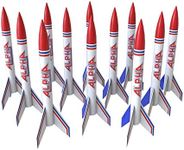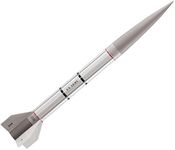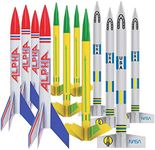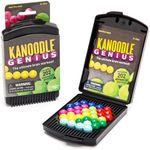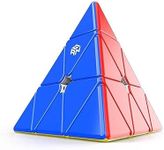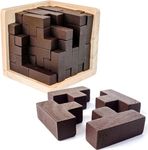Buying Guide for the Best Model Rocket Kits
Choosing the right model rocket kit can be an exciting and rewarding experience. Whether you're a beginner or an experienced rocketeer, selecting the right kit involves understanding various specifications that will affect your building and launching experience. By considering these key specs, you can ensure that you pick a model rocket kit that fits your skill level, interests, and goals.Skill LevelSkill level indicates the complexity of the rocket kit and is crucial for matching the kit to your experience and abilities. Kits are typically categorized from Level 1 (beginner) to Level 5 (expert). Level 1 kits are simple to assemble with minimal tools and are perfect for beginners or younger hobbyists. Level 2 and 3 kits require more advanced building techniques and tools, suitable for those with some experience. Level 4 and 5 kits are for advanced builders who are comfortable with complex instructions and detailed work. Choose a skill level that matches your current abilities to ensure a successful and enjoyable building experience.
Rocket SizeRocket size refers to the dimensions of the rocket, including its height and diameter. This spec is important because it affects the rocket's stability, visibility during flight, and ease of transport. Smaller rockets (under 12 inches) are easier to handle and store, making them ideal for beginners or those with limited space. Medium-sized rockets (12-24 inches) offer a good balance of visibility and stability, suitable for intermediate users. Larger rockets (over 24 inches) provide impressive flights and are best for experienced hobbyists with ample space for storage and launch. Consider your available space and desired flight experience when choosing the rocket size.
Engine CompatibilityEngine compatibility refers to the types of engines that can be used with the rocket kit. This is important because the engine determines the rocket's thrust, altitude, and overall performance. Engines are classified by letters (A, B, C, etc.), with each subsequent letter representing a higher power level. Beginners should start with lower-power engines (A or B) for safer, more manageable flights. Intermediate users can experiment with mid-power engines (C or D) for higher altitudes and more excitement. Advanced users may opt for high-power engines (E and above) for impressive, high-altitude flights. Match the engine compatibility with your skill level and desired flight performance.
Recovery SystemThe recovery system is the method by which the rocket returns to the ground safely after flight. This spec is important for ensuring the rocket can be reused and for minimizing damage upon landing. Common recovery systems include parachutes, streamers, and tumble recovery. Parachutes provide a gentle descent and are suitable for larger rockets or those with delicate parts. Streamers slow the descent but allow for a quicker recovery, ideal for smaller rockets. Tumble recovery involves the rocket tumbling back to the ground and is typically used for very small or lightweight rockets. Choose a recovery system that matches the size and weight of your rocket and your preference for recovery speed and safety.
MaterialThe material of the rocket kit affects its durability, weight, and ease of assembly. Common materials include plastic, balsa wood, and lightweight composites. Plastic kits are durable and easy to assemble, making them ideal for beginners. Balsa wood kits are lightweight and offer a more traditional building experience, suitable for intermediate users. Lightweight composites provide high strength and performance, best for advanced hobbyists looking for high-altitude flights. Consider your skill level, desired durability, and building preferences when choosing the material of your rocket kit.


